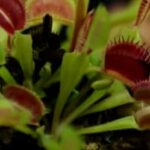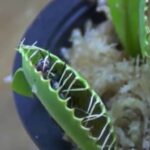As an Amazon Associate, this site earns commissions from qualifying purchases. For more details, click here.
Pitcher plants are carnivorous and eat all kinds of small bugs, whether they are in the wild or in a garden. With their need for meat-based nutrients, is it safe to give pitcher plants hamburger, hot dogs or other foods? While these plants are meat eaters, proper feeding is essential for their growth and health. There are meats pitcher plants can eat and some it cannot.
Pitcher plants can eat spiders, small insects and bugs. They cannot digest steak, hamburger or any meat meant for human consumption. Feeding human foods to carnivorous plants can cause serious harm.
Why Pitcher Plants Eat Insects
First we need to understand why pitcher plants eat insects as it is directly connected to their life cycle and health. The following applies to other carnivorous plants like Venus flytraps and sundews as well.
Plants need light, water, air and nutrients to survive and thrive. Pitcher plant soil does not have the nutrients it needs to grow. But these elements are present in insects so carnivorous plants eat them.
Sarracenia and nepenthes depend on photosynthesis to produce glucose. It is their food and provides energy for eating, producing leaves, etc. Glucose makes it possible for plants to live and grow, but it is not sufficient.
Non-carnivorous plants use nutrients from the soil to supplement glucose and pitcher plants have to do the same. Without additional elements like phosphorus, calcium etc. their development will slow or stop.
The problem is the environment pitcher plants grow in. The soil does has little to no nitrogen or any of the other elements. Over time these plants developed traps to catch insects and other bugs that do contain these elements. These nutrients are not only available in bugs but also carnivorous plant food like Amzey Store Dried Mealworms.
How Insects Benefit Pitcher Plants
Insect nutrients combine with glucose to make pitcher plants healthier. Proper feeding and nourishment enables pitcher plants to make more nectar to attract prey.. Their digestive fluids become more potent and pitchers larger.
By eating insects, these plants receive the nutrients that is missing from the ground. There are questions about whether you should feed pitcher plants at all but for many, there is no doubting its benefits.
Pitcher plants do not consume insects to live. They do so to make themselves stronger and healthier. It is no different from people who augment their diet with health supplements and vitamins.
Why Pitcher Plants Cannot Eat Human Food
It took millions of years for certain plants to become carnivores and develop traps to catch prey. While pitcher plants are meat eaters, there are limits to what they can and should consume.
Pitcher plants cannot digest foods for human consumption, including meats. Their digestive enzymes and acids are only capable of absorbing insects and other prey. Feeding pitcher plants bits of hamburger might seriously affect its health.
The way pitcher plants catch and digest prey evolved specifically for spiders, bugs and small insects. On some occasions a small frog or mouse might get eaten. But their digestion cannot handle foods that humans consume.
Venus flytraps, sundews, pitcher plants and other carnivorous plants eat insects because they contain nutrients. Their enzymes are also capable of dissolving these creatures so they can be absorbed along with their nutrients. Nepenthes however,, can and do eat fish food like TetraColor Plus Fish Flakes so you can try those as well.
Meats for human consumption do not have the nutrients these plants need. And even if it did, pitcher plants cannot dissolve or digest these meats.
The digestive fluids inside a pitcher plant are capable of dissolving tiny prey only. It cannot liquefy a large rat let alone hold it up in a pitcher. If you drop a piece of bacon there, the plant will just waste its enzymes trying to break it down.
The best way to think about this is to compare it with humans. We do not eat anything unless we are sure it is edible. We are very careful to avoid an upset stomach or even something worse. The same applies to pitcher plants.
What Happens If Pitcher Plants Eat Human Food?
If you drop bits of hot dog in a pitcher, either one of two things will happen. One, the plant will ignore it. That piece of hot dog will just remain in the liquid. The plant will not eat it, leaving the meat to rot. If a crab spider or another bug is in the pitcher, it might eat the hot dog.
It is also possible a pitcher plant might try to digest the meat. When a pitcher plant catches a prey, liquids in the pitcher coupled with digestive enzymes dissolve its tissues. A pitcher plant might try to do the same thing with a hot dog, but it will probably fail.
Most likely its digestive enzymes will not be able to dissolve the hot dog. A bigger problem is if it does succeed and the plant eats the meat.
If this occurs there is no telling what its effect will be on the plant. If it was just a small piece, probably nothing. But if you keep feeding hot dogs and the pitcher plant somehow kept eating it, this can be fatal.
Your pitcher plant might die suddenly or slowly weaken. Signs of weakness include pale colors, leaves turn black or brown and no longer eating. The plant may stop producing liquids for its pitchers as well. There are however, many reasons why a pitcher plant may be empty, so you have to find out first.
While pitcher plants can eat many types of insects, that does not mean they can eat anything. If you want to give them something new, try fish food or mealworms. Pitcher plants eat live and dead prey. As long as they contain nutrients they will help with growth and development.
Considerations For Feeding Pitcher Plants
Nutrition is important for pitcher plants, and you need to take the proper approach. Even though there are many species and variants, the following guidelines are applicable to all of them.
- Feeding properly is a must for any indoor pitcher plant. It is one of the many factors that can help pitcher plants come back every year .
- If the plant is outdoors it can scour food for itself. All you have to do is look inside its pitchers and you will see remains of various bugs.
- Pitcher plants do not require a lot of nutrients. It is okay to feed them once a month though many owners prefer weekly or every two weeks.
- Do not fill the pitchers with too much water. That is not going to help drown prey.. Excess water dilutes the liquids in the trap and could kill helpful bacteria there.
- Do not fill the pitcher with too many bugs. If your pitcher plant is outside and you see a lot of insects in its pitcher, that is fine. But do not go out of your way to stuff it with food.
Pitcher plants can only eat if they are in a healthy environment. The key is to replicate their natural habitat as accurately as possible.
Nepenthes pitcher plants prefer a tropical climate. Keep them in temperature around 65-85 F and 50% humidity. A warm, humid, wet setting is ideal. Maintain this condition all year long and feed regularly. Move the plant indoors during winter.
Sarracenia go dormant in winter and emerge in spring. They require more light than nepenthes and are best grown outdoors. They can grow in temperature up to 90 degrees but do need more water.
All pitcher plants have to be kept in moist, nutrient free soil. Even though they do not get nutrient from the ground, carnivorous plants still need them.
If you are growing pitcher plants indoors, freeze dried mealworms or fish food are the best options. Unless you like to catch insects, it is an easier solution and just as good.
Conclusion
It might tempting to give a piece of bacon or hamburger to your pitcher plant just to see what happens, but resist it. These plants are not picky with food, but they are simply not meant to consume processed and cooked meat meant for us humans.

My fascination with carnivorous plants began many, many years ago with Venus Fly Traps. Now I am more than happy to impart what I know with other enthusiasts and those who are curious about meat eating plants.



